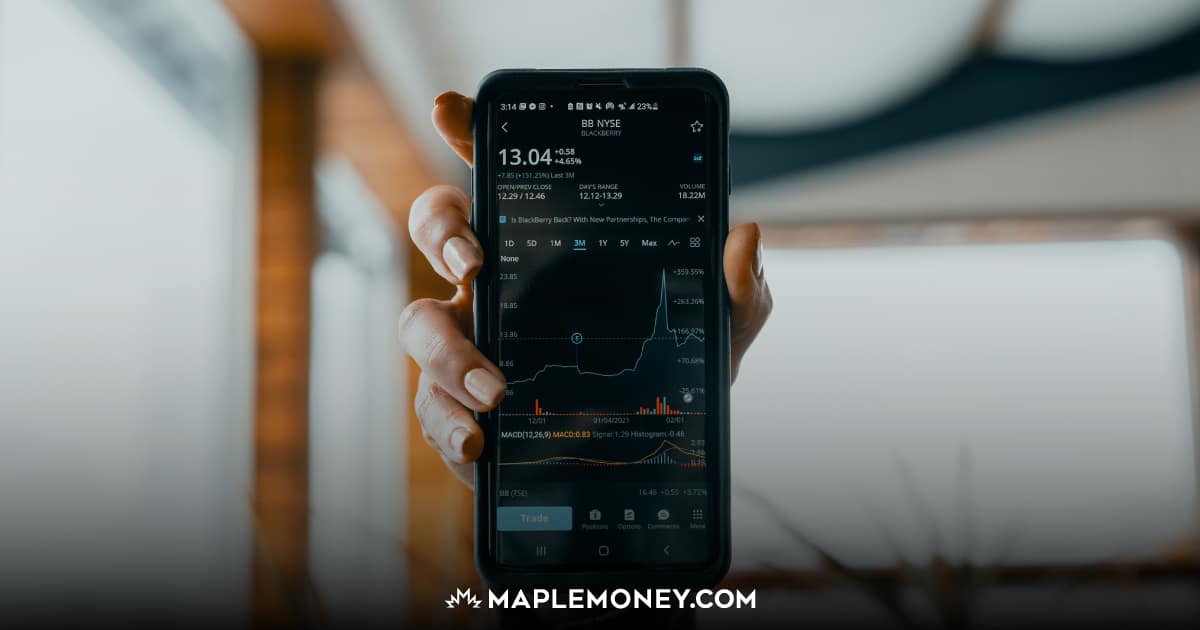Best Index Funds in Canada: 9 Index Mutual Funds and ETFs for You to Consider

Canadian investors know the easiest way to build a diversified portfolio is through low-cost index funds. But what is an index fund, anyways? Is it a mutual fund? An exchange-traded fund (ETF)? Both? The truth is that in recent years, the lines have been blurred between index mutual funds and ETFs.
In this article, I explain what an index fund is, and the differences between index mutual funds and ETFs, and I share my list of the best index funds in Canada. Here’s a hint: the list includes mutual funds AND ETFs.
What Is an Index Fund?
An index fund is a type of mutual fund or exchange-traded fund (ETF) that attempts to replicate the performance of an underlying stock markets index, such as the S&P/TSX Composite Index in Canada or the S&P 500 or Dow Jones Industrial Average in the U.S.
Index fund managers purchase the same stocks in the tracking index. Depending on the fund, they may also match each stock’s weighting within the index or assign each stock an equal weighting.
Either way, index fund managers follow a passive investing strategy. They aren’t looking to make regular trades; their goal is to achieve returns that equal the benchmark index. This approach keeps the cost of managing index funds very low, which benefits investors.
With actively-managed mutual funds, managers buy and sell securities regularly to try and achieve better-than-market returns. And occasionally, they do just that, although history shows that actively-managed mutual funds almost always underperform their passive counterparts (index funds). Part of the problem is fees.
The increased activity of an actively managed fund drives up expenses, resulting in higher management and administration fees, eating into investor returns. Actively managed mutual funds can charge fees of 2% or more annually, while passive index mutual funds are often well below 1%. Exchange-traded funds are even lower, with some MERs below 0.10% annually.
Index Mutual Fund vs. ETF Index Funds
Index mutual funds and index ETFs have many similarities. In fact, mutual fund companies are blurring the lines as of late by holding ETFs inside their index mutual fund products as a way to reduce costs. Some index mutual funds even include ETF in the name, which can be confusing (BMO does this).
Both types of investments hold large numbers of underlying assets, like stocks and bonds, and both follow a passive investment strategy. The biggest difference between the two products is that ETFs can be traded like stocks on the exchange, while mutual funds can only be purchased once a day, making ETFs slightly more liquid than mutual funds.
Another differentiating factor is the low cost of ETFs. Index mutual fund fees have come down in recent years as investors have flocked toward individual stocks and ETFs, but ETFs remain the cheaper of the two. It’s common to find broad market index ETFs with MERs under 0.10 %.
Best Index Funds (and ETFs) in Canada
I’ve separated our list of Canadian index funds into two groups: the mutual fund version and the ETF version. Given the latter’s popularity, I’ve included three index mutual funds and six ETFs. I’ve categorized the funds under Canadian Equity, US Equity, and International Equity. For this post, I’ve excluded funds in smaller categories, such as bonds, small-cap, or emerging markets.
Best Index Mutual Funds
You’ll notice that two of the three funds on our list are TD eSeries funds. TD has led the way with this family of funds for many years, and while ETFs appear to be the future (and the present) of index investing, TD is still investing in eSeries. In recent years, they’ve found unique ways to lower costs further. In addition, you can now purchase TD eSeries funds from several Canadian online brokerages, which wasn’t always the case. I’ve also included a longstanding RBC index mutual fund on our list.
Candian Equity
TD Canadian Index-e
Ticker: TDB900
Management Expense Ratio (MER): 0.28%
Assets Under Management (AUM): $1.5 billion
Top 3 Holdings: TD Canadian Equity Index ETF (34%), Royal Bank (4.1%), TD Bank (3.6%)
What We Like: One of Canada’s largest index funds with a very low MER.
The TD Canadian Index fund uses the Solactive Canada Broad Market Index as its benchmark. The index is built to replicate the performance of the all-cap segment in the Canadian stock market. The fund’s largest holding is a TD ETF (TTP), but it also holds individual stocks for enhanced exposure to specific sectors, such as financials and energy.
US Equity
RBC U.S. Index Fund F
Ticker: RBF5737
Management Expense Ratio (MER): 0.21%
Assets Under Management (AUM): $500 million
Top 3 Holdings: Apple, Microsoft, Amazon
What We Like: Exposure to S&P Total Return Index
If you’re looking for exposure to the S&P 500 in an index mutual fund, the RBC U.S. Index Fund F is a solid option. The fund has a low MER of only 0.21%
International Equity
TD International Index – e
Ticker: TDB911
Management Expense Ratio (MER): 0.46
Assets Under Management (AUM): $688 million
Top 3 Holdings: TD International Equity Index ETF (TPE), iShares MSCI EAFE ETF
What We Like: No trading fees when purchased through TD Direct Investing
TD’s eSeries index mutual funds manage to lower costs by holding other ETFs instead of individual stocks. Not only that, but they’ve switched to tracking Solactive indexes in recent years for additional cost savings.
This fund uses the Solactive GBS® Developed Markets ex-North America Large & Mid Cap CAD Index as its benchmark. Its top holding is the TD International Equity Index ETF (TPE), which I cover in more detail below.
Best Index ETFs in Canada
Canadian investors can choose from more than 1000 Canadian-listed ETFs, but I’ve selected six among the top performers in their respective categories for various reasons.
Candian Equity
1. Vanguard FTSE Canada All Cap Index ETF
Ticker: VCN
MER: .05%
AUM: $5.30B
Top 3 Holdings: Royal Bank, TD, Enbridge
What We Like: Low MER of .05%, all-cap exposure
The Vanguard FTSE Canada All-Cap Index ETF is a highly diversified Canadian Equity ETF. It provides investors with exposure to the entire Canadian market, holding small, medium, and large-cap stocks. The ultra-low MER of 0.05 is among the lowest in the industry.
iShares Core S&P/TSX Capped Composite Index ETF
Ticker: XIC
MER: .06%
AUM: $8.8B
What We Like: Like VCN, the iShares Core S&P/TSX Capped Composite Index ETF has a very low MER (.06%). The fund invests in the largest and most liquid Canadian corporations listed on the TSX; however, individual holdings are capped at 10% to avoid overweighting any one company.
U.S. Equity
iShares Core S&P U.S. Total Market Index ETF
Ticker: XUU
MER: .07%
AUM: $2.3B
What We Like: Access to the entire U.S. market.
If you want exposure to the total U.S. stock market in Canada, this is the way to do it. Unlike S&P 500 ETFs, the iShares Core S&P U.S. Total Market Index ETF covers more than 3500 large, medium, and small-cap companies. The MER is a paltry 0.07%.
Vanguard S&P 500 Index ETF
Ticker: VFV
MER: .09%
AUM: $7.0B
What We Like: Great for exposure to the largest U.S. companies
Vanguard’s S&P 500 Index ETF offers investors exposure to the largest companies in the U.S. The massive fund, with over $7 billion in assets under management, has an MER of only .09%. Whether you hold small and medium-cap U.S. stocks in another ETF or you just want exposure to the largest companies, this is a great option.
International Equity
iShares Core MSCI All Country World ex Canada Index ETF
Ticker: XAW
MER: .22%
AUM: $1.6B
What We Like: A truly global ETF,
Remember that you can’t achieve real diversification without exposure to markets outside of Canada. iShares Core MSCI All Country World ex Canada Index ETF is a global fund with a reasonable MER of 0.22%. Keep in mind it does have a 60% weighting in the U.S. market. You may decide that’s too much if you already have exposure through a U.S. Equity ETF, like VFV.
If so, the next ETF on our list may be more suitable.
TD International Equity Index ETF
Ticker: TPE
MER: .19%
AUM: $1.1B
Top 3 Holdings: Nestle SA, Roche Holding AG, AstraZeneca PLC
What We Like: Low MER, ex-US.
If you already own a U.S. index fund or ETF, the TD International Equity Index ETF (TPE) may fit perfectly in your portfolio. In addition to an incredibly low MER for an international fund, TPE has almost no U.S. exposure (1.0%). It’s focused primarily on the Asian and European markets, at 38.0% and 28% of holdings, respectively. Notable holdings include Nestle SA, Shell, and Toyota Motor Company.
How Do I Add Index Funds to My Portfolio?
If you’re ready to buy index funds, the next step is adding them to your portfolio. Most investors should consider index funds or ETFs core holdings because of their low cost and the diversification they offer. Because index funds hold so many underlying securities, you can build a well-diversified portfolio without large sums of money.
However, you must be mindful of including the proper mix of index funds. For example, you will want to ensure exposure to Canadian, U.S., and international markets.
You can do this in several ways, but one way is to purchase three index funds: a Canadian fund, a U.S. fund, and an international fund. If you have a dedicated U.S. fund, just make sure that your international fund is ex-U.S. to avoid overexposure to that market. That’s one of the things I like about TPE above – I don’t have to worry about overlapping my U.S. holdings.
Rebalancing
If you use a three-fund portfolio, keep in mind that you will need to look after rebalancing these funds regularly. For example, let’s say your portfolio is divided into a 40/40/20 split, with 40% Canadian, 40% U.S., and 20% International. Over time, these weightings will shift, and you may end up with something that looks quite different, say 60/30/10.
When that happens, you’ll need to place trades and adjust the balances of each fund to retain your target weighting, e.g., 40/40/20. Rebalancing can be time-consuming, and if you have trading fees, it can also cost money.
To avoid the hassle, you can purchase all-in-one ETFs instead. You can hold your entire portfolio in a single fund with an all-in-one. They cost more, but the funds are rebalanced for you, so there’s no work on your part.
For more information, check out my article on the best all-in-one ETFs in Canada.
Other Portfolio Considerations
Remember that the index funds included in this article are all equity funds. They invest almost exclusively in Canadian, U.S., and International stocks and offer little to no exposure to income investments, such as bonds or real estate.
As you invest, you’ll want to decide what percentage of your portfolio should be in equities (stocks) and how much should be in low to medium-risk investments, like bonds, real estate, etc.
To reduce portfolio volatility, the vast majority of investors should have a mix of income and equity investments.
You should always consult an investment professional to determine your ideal asset allocation. They will consider your overall investment objective, time horizon, risk tolerance, and other factors.
Where Can I Buy Index Mutual Funds and ETFs?
You can purchase mutual funds through a financial advisor at any Canadian bank or credit union; however, ETFs can only typically be purchased in person from a bank advisor if they have the proper licensing.
The easiest and most convenient way to purchase mutual funds or ETFs is by opening an online brokerage account. That way, you can manage your portfolio and place trades from the comfort of your living room.
There are at least a dozen online brokers in Canada. TD Direct Investing is great for mutual funds, as they don’t charge trading fees on hundreds of funds. Unfortunately, they charge $9.95 for stock and ETF trades.
For ETFs, I recommend Questrade or Wealthsimple Trade.
You can open a Questrade account online and begin trading as soon as you fund your account. The best part about Questrade is that they offer free ETF purchases. The same goes for Wealthsimple Trade, although their platform lacks Questrade’s functionality. Note that Questrade charges $9.95 for mutual fund trades.
Click here to get started with Questrade
Final Thoughts
If your portfolio consists primarily of actively managed mutual fund investments, it may be time to consider switching to passive mutual funds or ETFs. The problem with owning traditional mutual funds is that you’re paying higher costs for what is likely subpar performance.


